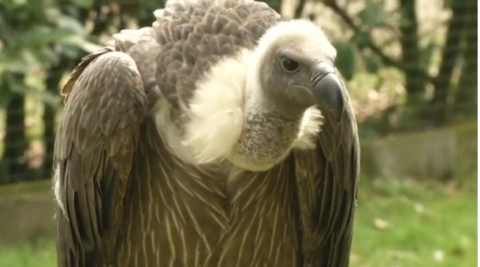
HAMPSHIRE, United Kingdom (Reuters) — Vultures are synonymous with scavenging – feeding off the carcasses of other animals. Naturalists have long believed that many aspects of these species’ biology evolved to maximize the efficiency of this feeding behavior, and this seems to crucially include their vision which is specialized for scanning the ground while flying and keeping the sun out of their eyes while doing so.
This has led to a troubling phenomenon: vultures are liable to fly into man-made objects such as power lines and wind turbines.
“They’re not looking at where they’re going; their whole visual set-up is designed to be looking down. And it’s this that makes them so prone to flying into man-made objects ahead of them,” explained Steve Portugal from Royal Holloway University of London.
However, one particular species – the white-headed vulture – doesn’t seem to have this problem. New research has proved that this particular vulture – Trigonoceps occipitalis – employs a predatory hunting technique more similar to diurnal hunting raptors and this makes it less vulnerable to collisions.
“We noticed that the white-headed vulture perhaps had a different visual system, some different morphology, some different behaviors that meant it wasn’t so prone to flying into these man-made structures,” added Portugal.
Binocularity is a key component for hunting birds. This gives them the ability to accurately determine the position and time the arrival of their talons when attempting to capture prey.
Researchers measured the visual fields of white-headed vultures and compared it with two species known for exclusive carrion-feeding: the African White-backed and Eurasian Griffon vultures. Graham Martin of the University of Birmingham said it was similar to the technique used in a human eye test.
“We simply examine the eye with an ophthalmoscope,” explained Martin.
“We’re moving around the bird and working out where we can and cannot see into the eye, whether we can see into both eyes at the same time.”
Research published in IBIS, the international journal of avian science, states that the maximum binocular field of the white-headed vultures is close to birds which take live active prey, such as red-tailed hawks and American Kestrels.
“What we found was that the white-headed vultures actually have a visual system, a visual set-up, that’s more similar to active hunting hawks and eagles and much less like their close relatives. This is because it turns out white-headed vultures actively hunt prey, this means they must be able to make contact with their talons onto a moving object, which vultures feeding on carcasses are never going to have to do,” said Portugal.
While the white-headed vulture may stand a better chance of avoiding collisions with man-made structures, the problem is on the rise, as more objects that intrude into the open airspace are built in birds’ natural habitat.
The researchers hope that increased understanding of avian eyesight could help reduce the collision probability of vultures and other large raptors with man-made objects.
“Unfortunately, where it’s good to place a wind farm to maximize the energy from it is also where birds like to hang out and also take advantage of this wind. This can have huge problems,” said Portugal.
He added that man-made objects present a perceptual challenge that the vision of foraging vultures and other birds cannot readily overcome.
“What the information from this study has done is really help us to understand how different species of birds see the land differently, how they operate within their home environment. And the hope now is that this can inform, for example, management decisions about where wind farms should be placed and come up with some practical measures to try and stop this problem,” said Portugal.
Britain’s Royal Society for the Protection of Birds (RSPB) says this problem is particularly prevalent on migration routes, where man-made structures are situated on migration bottle necks through which large numbers of birds pass annually. It is when birds pass through these sites on migration that the major toll of their numbers occur.
“Some poorly sited wind farms have caused major bird casualties, particularly at Tarifa and Navarra in Spain, and the Altamont Pass in California. At these sites, planners failed to consider adequately the likely impact of putting hundreds, or even thousands, of turbines in areas that are important for birds of prey,” the RSPB’s website states.
Vultures are vital to the ecosystem and human health, helping to stem the spread of disease on the world’s poorest continent by eating carcasses that would otherwise rot. But deliberate or indiscriminate poisoning has seen a huge decline in their numbers in Africa. The white-head vulture is classed as critically endangered, meaning it faces a high risk of extinction.







